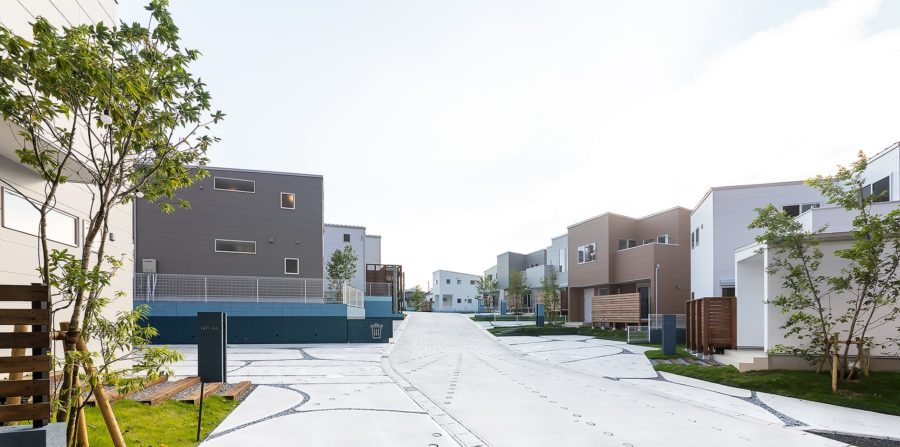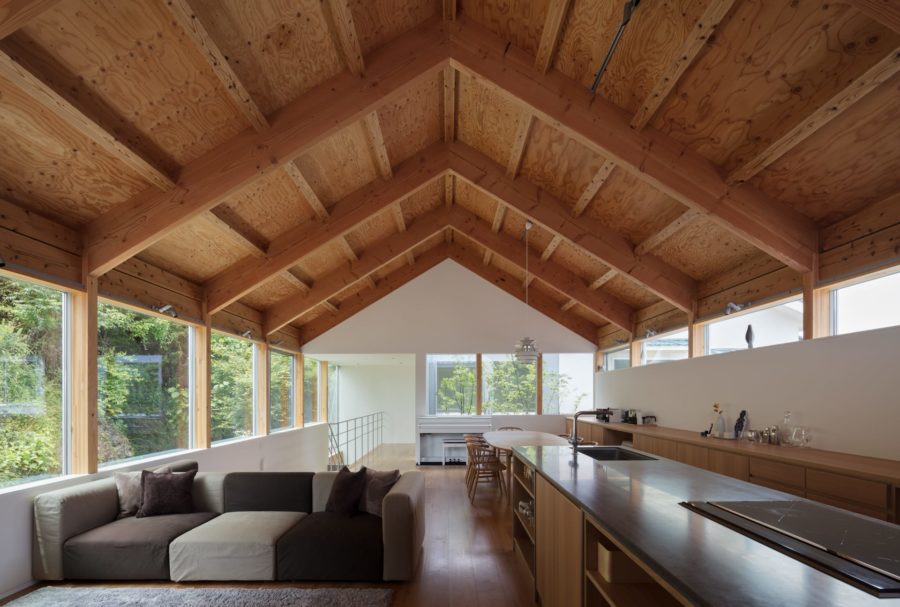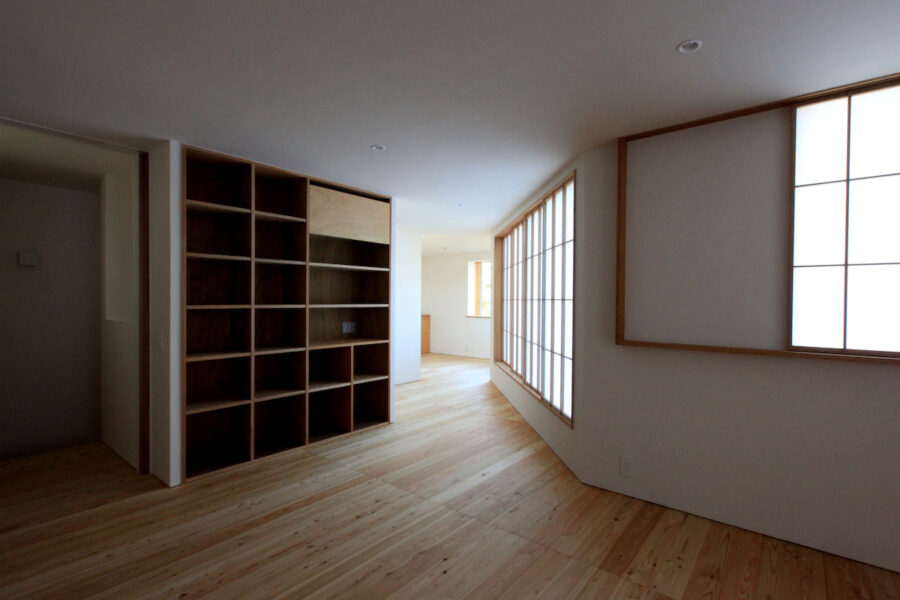デザインを探求しこの先のデザインを育む、未来のつくり手たちのための場所。
日本で最初のデザイン学校である専門学校桑沢デザイン研究所新教育施設の1期工事。
現校舎からほど近い場所にある建物を全面的にリノベーションし、現校舎と併用して運用することで機能の充足を図ることから計画は始まった。
1期工事では地上1階から4階までを改修範囲とし、建物の横に長くシンメトリーな形状を活かしたレイアウト計画と、ユニバーサル化に伴う設備の一新や、効率的な動線計画による開放的な施設を目指した。
1階から3階は、中央にパブリックなエリアを設け、その両側にイベントスペースや教室など機能をもったスペースを配置するように計画している。
イベントスペースは、学校と外とを繋げるパブリックでフレキシブルなスペースにしたいという要望から、ファサードからの視認性を考慮した明るく開放的な空間とし、エントランス横から直接アプローチできるようになっている。
2、3階の教室間の中央に配したパブリックスペースにはベンチとハイテーブルを設け、生徒同士の繋がりや交流を生むスペースとして授業間の隙間時間をより有意義なものにする。
4階は面積の半分以上が屋外で、代々木競技場と緑豊かな代々木公園を借景として望みながらデッキ貼りのテラスとし、造作のベンチ、大きなテーブル、カウンターを設け各所に豊かな植栽を植えることで外部との繋がりを意識した、気持ちのよい場所として都会にいながらも自然を享受できる場所になればと考えた。
1990年代に建てられたこの建物は、ポストモダンの空気を感じさせる特徴的なコンクリートの外観となっており、内部は大理石が貼られた壁や板張りの床など古めかしい当時の内装が残っていた。
外観との対比を図るため、内装はあくまで数十年先を見据え恒久的なニュートラルさを意識し装飾は抑えつつ、渋谷と原宿の中間地点ということもあり、都会的なエッジを付加するようにデザインをした。
本校がドイツのバウハウスのデザイン理念をもとに創設された経緯から、内装のマテリアルにはモダニズムの進歩を押し進めたスチール、ガラス、コンクリートをメインに使用し、手摺やサッシはデッサウで用いられたディティールを現代的にアップデートすることで、リノベーションによる新旧と当時のバウハウスと現代のデザイン学校として桑沢に相応しい空間にしようと考えた。
要所に配したシンプルなアールの手摺や特注のカーテン、ファブリック、既存の大理石をアップサイクルした研ぎ出しの天板などによって、機構や機能が素の姿として空間を形成していく中で出てくる直線による強さを柔和し、人間的な暖かみを空間にもたせている。
スケルトンに塗装をした白い箱の中に多用したニュートラルなグレー(主張のない工業製品的なグレー)は、どこか都会的でありながらも中庸であり、デザインを探求する生徒たちそれぞれの”色”を引き立たせる意味をもっている。
上記の要素により、この先もその普遍的な印象をもつ校舎は、都会の中で学ぶ学生にとって、自身の学びにフォーカスできるバランスを担う役割をもち、日本で最初のデザイン学校としての歴史を継承する大らかな受け皿として、この先も機能していくことを期待する。(志摩 健)
A vocational school with a modern update of the Bauhaus design philosophy
A place for future creators to explore design and nurture the design of the future. The first phase of construction of the new Kuwasawa Design School building, the first design school in Japan.
The project began with the complete renovation of a building located not far from the current school building, with the aim of enhancing its functions by operating it in tandem with the current school building.
The first phase of the project covered the first to fourth floors above ground, The layout plan was designed to take advantage of the building’s long, symmetrical shape and to create an open facility by renewing the facilities and planning efficient flow lines in accordance with the universalization of the building.
The first through third floors are planned to have a public area in the center, with event spaces, classrooms, and other functional spaces on either side.
The event space was designed to be a public and flexible space that connects the school to the outside world.
The public space in the center between the classrooms on the 2nd and 3rd floors is furnished with benches and high tables, creating a space for students to connect and interact with each other and making the gaps between classes more meaningful. More than half of the fourth floor is outdoors, with a decked terrace overlooking Yoyogi Stadium and the lush greenery of Yoyogi Park.
The terrace has a built-in bench, a large table, and a counter and is planted with abundant greenery.
Built in the 1990s, the building has a distinctive concrete exterior that evokes a postmodern atmosphere, while the interior retains the old-fashioned interior of the time, with marble-clad walls and wooden floors. In order to contrast with the exterior, the interior was designed to be permanently neutral with an eye on the next few decades, with minimal decoration, while adding an urban edge to the building, located between Shibuya and Harajuku.
The school was founded based on the design philosophy of the *Bauhaus in Germany, so steel, glass, and concrete, which pushed forward the progress of modernism, were the main materials used in interior design.
The idea was to create a space appropriate for Kuwasawa as a design school for the old and the new, for Bauhaus at the time, and for the present.
The simple curled railings, custom-made curtains, fabrics, and polished marble tops upcycled from existing marble soften the strength of the straight lines that emerge as the mechanisms and functions form the space as they are and give the space a human warmth.
The neutral gray (industrial gray without assertiveness) used in the white box painted on the skeleton is somewhat urban yet moderate and is meant to accentuate the individual “colors” of the students who are pursuing their own designs.
The above elements will continue to create a universal impression of the school building, which will serve as a balance for students to focus on their studies in the city.
We hope that the school will continue to function as a generous receptacle for students to carry on the history of Japan’s first design school. (Takeshi Shima)
【Kuwasawa Design School #1】
所在地:東京都渋谷区神南1-4-22
用途:専門学校
クライアント:学校法人桑沢学園
竣工:2023年
設計:moss.
担当:志摩 健
電気設備:KENT
照明設計:Filaments
研ぎ出し・左官:ADDICT
植栽:Tan(Timber Crew)
施工:STUDIO
撮影:藤井浩司(TOREAL)
工事種別:リノベーション
構造:RC造
規模:地上4階、地下1階
敷地面積:243.44m²
建築面積:197.72m²
延床面積:881.60m²
設計期間:2022.06-2022.12
施工期間:2022.12-2023.03
【Kuwasawa Design School #1】
Location: 1-4-22 Jinnan, Shibuya-ku, Tokyo, Japan
Principal use: Vocational school
Client: Kuwasawa Gakuen Educational Association
Completion: 2023
Architects: Moss.
Design team: Takeshi Shima
Electrical equipment: KENT
Lighting Design: Filaments
Polishing and plastering: ADDICT
planting plan: Tan / Timber Crew
Contractor: STUDIO
Photographs: Koji Fujii / TOREAL
Construction type: Renovation
Main structure: RC
Building scale: 4 stories and 1 below
Site area: 243.44m²
Building area: 197.72m²
Total floor area: 881.60m²
Design term: 2022.06-2022.12
Construction term: 2022.12-2023.03








